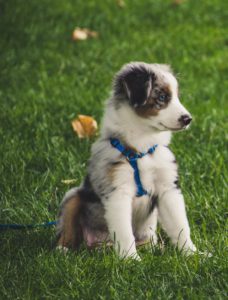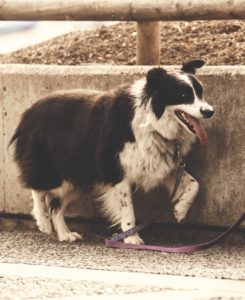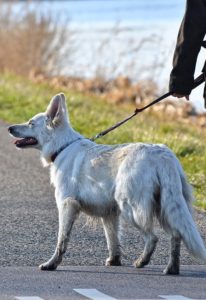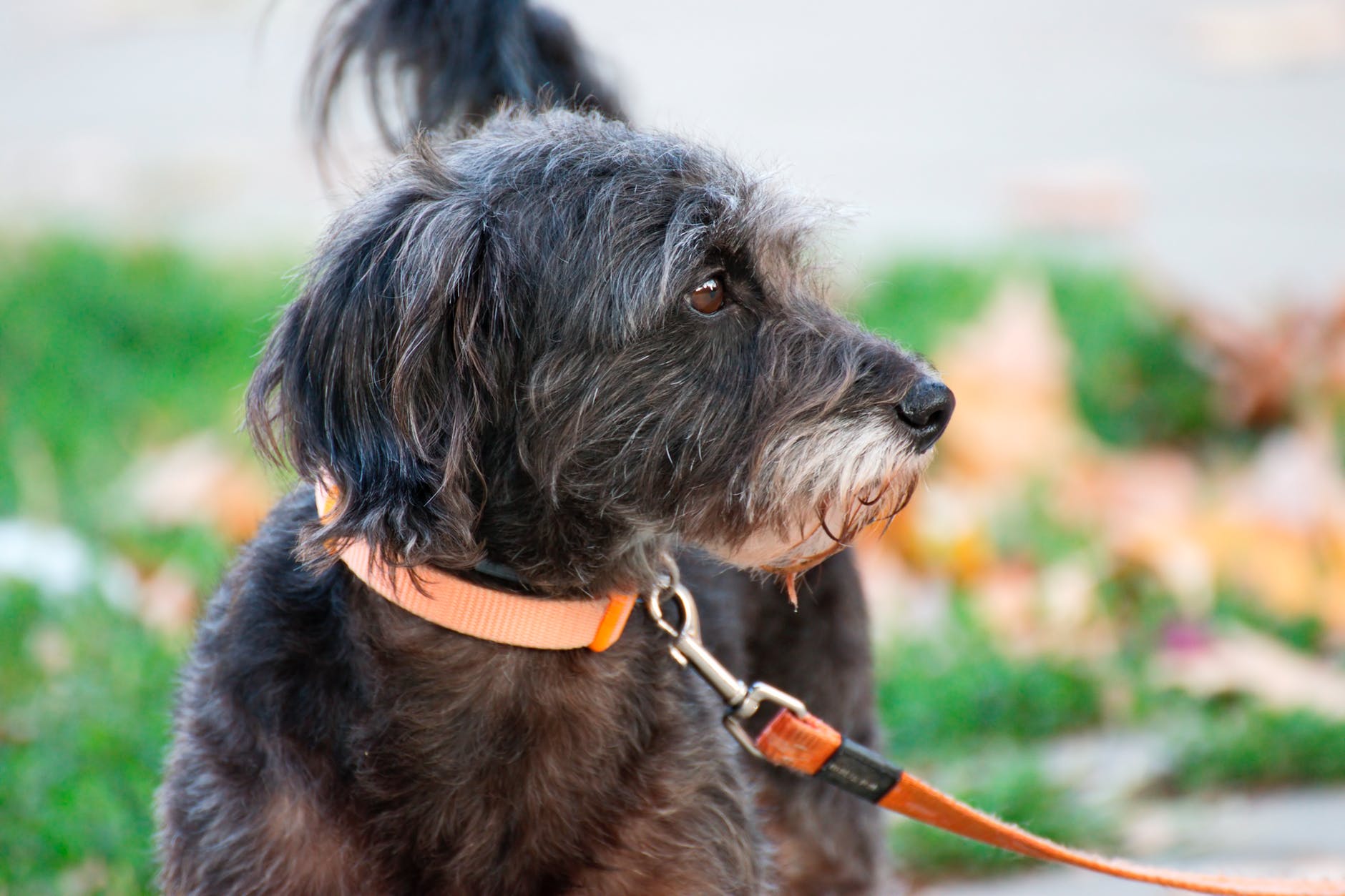I am so excited to be living in my own apartment.
I finally got out of mom and dad’s place, and that means I can live my own life-which is a very active one!
I love going for walks and I enjoy playing outside with friends. We do all kinds of fun things like Kan Jam, Ultimate Frisbee and volleyball.
It also means I can have a dog now-hooray!

My name is Anna, and I and I want to tell you about my tips for training your puppy to walk on a leash.
I adopted my little friend Zip from the local shelter. She’s a Terrier mix and just loves to be outdoors with me.
Training her on a leash was hard for me, as I had never trained a dog of my own before.
I turned to the Internet for help. There was so much information out there that it overwhelmed me!
I had to condense it down and make it easier for everybody who owns a high-energy pup like mine.
My methods worked, and now Zip and I go everywhere when the weather is nice!
She comes with me on my runs and even walks to the store with me.
I first learned of this information by reading Martin Deeley’s article on the Cesar’s Way website.
These tips worked for me and my friends and family!
1) Be Patient!
Every dog is different. Every dog can and will learn how to walk on a leash, but only if you are patient and take your time to get to know that dog.
Be sure to bring treats when you teach. Positive reinforcement is a great learning method.
Some dogs will not respond well to a leash and collar, even if it is necessary.
My city has leash laws, and my apartment says dogs must be on a leash while on the premises. Be sure to approach your dog with calm, confident tones of voice.
Try a few collars to find one that suits your dog. Offer a treat when he or she puts the collar on.
Make sure to give praise and pets or belly rubs throughout the process.
Just take it slow and work at the pace of your dog.
2) Choose the Right Collar and Leash
For my little lady, I chose a simple light, flat collar and a light leash.
To check you are fitting a collar correctly, check out this article!
She’s young, so this works well. For an older dog, you might need something different.
For a puppy, this type of collar and leash arrangement should work just fine.
You can always get a different collar later on if needed.
For help choosing a collar click here!
3) Take Small Steps
Learning to walk your puppy on the leash is not going to be easy, but you can do it.
If your dog is anything like Zip, she just wants to run and play with all the squirrels around the apartment and sniff every tree and lamppost.
By taking small steps, you can ensure a great walking experience for everyone.
Start by getting your dog used to wearing a collar. Do this in a calm setting-avoid a place that might make your dog associate the collar with a fearful or stressful time.
For some dogs, just attempting to put the collar on can induce stress.
If your dog is like this, put the collar on him or her when there are distractions about-a chew toy, a rawhide bone, or other welcome distraction.
You will want to attach the collar in your home or in your yard.
Don’t do it at the pet store or other public places. This can be too stressful.
Put it on so it is snug, but not too tight. Interact and talk with your dog so he is distracted and not worried about the collar.
You might even put it on during his meal, or during some dog training.
By doing this, your dog will accept the feeling of the collar and the leash, especially if it is associated with good times like eating food and treats.
If your dog scratches at the collar, get his attention with a toy or have him start to follow you.
This way, his mind goes off the collar and onto the task at hand. He will get used to it over time and forget it is there.
4) Playtime=Leash Time
For some dogs, putting a leash on means they have to simply get away. They feel trapped!
If this is the case with your dog, supervise him in an enclosed area by putting the leash on him and letting him run around, dragging it as he goes.
Supervise him so that he doesn’t get caught on something or hurt.
You might also bring in another dog for some playtime while he wears the leash.
If no other dog is available, you can play with the dog or even have him learn a command, like fetch.
You might even set him down with a toy.
When he gets comfortable, pick up the leash and call his name. I did this method with Zip, and it worked well.
She was able to have fun with her favorite tennis ball and learned to associate the leash with her tennis ball.
She knows that she cannot play ball unless we have the leash-the dog park is a short walk from my building.
 One other thing to consider is the sort of dog that barks at other dogs while walking.
One other thing to consider is the sort of dog that barks at other dogs while walking.
This is a behavior to correct for a few different reasons: keeps the noise down and keeps everybody in a good mood.
The way to go about fixing this is by making sure your dog gets a good amount of exercise and mental stimulation.
Provide toys, and make sure you can let him or her out for some free play or go on a walk each day. If your dog still barks, create distance and offer a treat before the behavior takes place.
This will redirect his attention.
Once your dog comes to you on the leash, offer a small morsel of a treat for good behavior. Don’t give them a big chewing treat, as this takes away from learning time.
5) Offer Encouragement
When you first hold the leash, don’t try to get the pup to walk at your feet just yet. Some dogs do this naturally, which is great.
Zip just wanted to pull and run! Do not yank him or her back to try and get them to walk with you.
Approach everything with a calm and gentle demeanor.
It is advised to stand still and let him process what is going on. Do not move when he pulls-he must learn that you are in control.
You might go in circles a few times, but the puppy must learn that his or her keeper controls the walk, not the other way around.
Stay calm and be patient. This might take a while.
In some cases, it is best to practice indoors to minimize distraction. I put Zip on her leash in the apartment and we walked down the stairs.
Doing it outside for the first time would have meant that she got distracted by the squirrels. She probably would have taken off running-and that’s something nobody wants to deal with!
Let your dog process what the leash does. Let your dog see that it is just a tool for safety, not a bad thing at all.
Let him gain confidence in the leash and in you. Offer a treat to him when he walks at heel with you to teach him it is the place to be.
Walk away, and then offer a treat every so often to reward the good walking behavior.
Some dogs might not want to walk. Some just sit right down and refuse to make any moves. If this happens, walk a few steps away and get down on one knee.
Encourage your dog to come to you and offer him or her a treat. Once this is complete, start walking once more.
If your dog is the type that has concerns, and even if they’re not, having a collar and a leash on can create a sense of restriction and resistance in your dog.
There are dogs out there that naturally walk with you, but the second that they have a leash on, they just want to pull away and behave completely different.
Final Thoughts

The important thing to do is just take your time and have fun with the process.
Go slow and be persistent in your training techniques. Even if you only make a small bit of progress toward your ultimate goal, it’s something to be proud of.
The small steps are key to making what you want. Just keep at it, and eventually, you will have a dog that doesn’t mind putting on his leash and going for a walk.
It was certainly a rewarding and fun experience to train Zip to walk on the leash. It wasn’t easy by any means.
She certainly backed away from the leash at first. That was a chore in and of itself.
I simply laid a treat down followed by a toy, and that made things a little easier. It still took a few tries to get it on, and then it was even harder to stop her from scratching at it.
I was thankful for her tennis ball to serve as a little distraction. Now she wears it with pride and doesn’t think twice about it.
After they have mastered being on the leash you may want to teach them some amazing tricks found in this article!
So, what do you think?
Leave us a comment with your ideas and thoughts. Share this post for even more fun!

